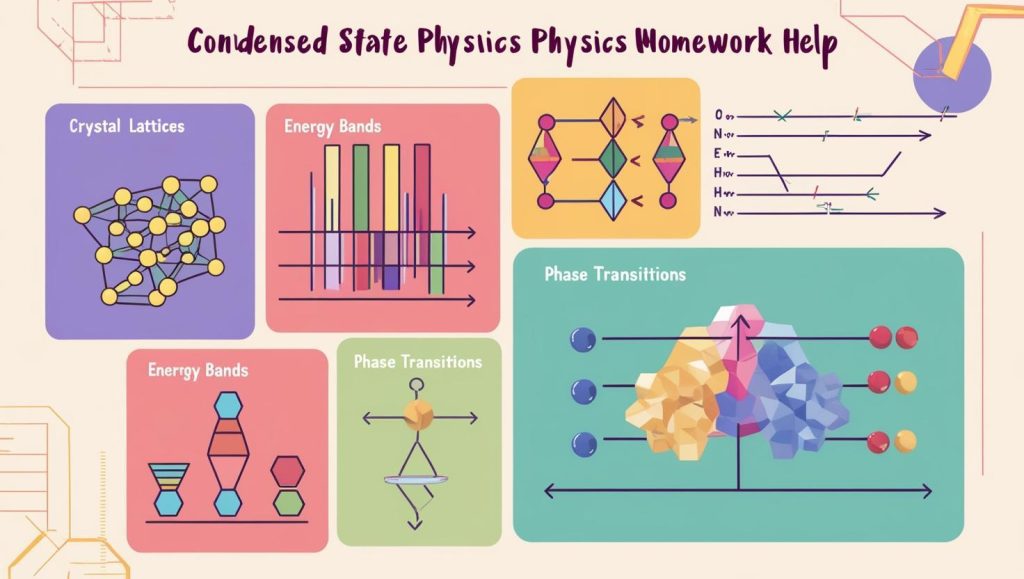Condensed state physics, also known as condensed matter physics, is a fundamental branch of physics that studies the physical properties of condensed phases of matter, such as solids and liquids. This guide provides comprehensive Condensed State Physics Homework Help, covering essential topics, problem-solving strategies, and useful online resources.

Understanding Condensed State Physics
Condensed matter physics is one of the most active and diverse fields of physics. It explores various states of matter, including:
- Crystalline Solids: Characterized by a periodic atomic structure.
- Amorphous Solids: Lacking long-range atomic order.
- Superconductors: Materials that conduct electricity without resistance.
- Magnetism: Interaction of magnetic fields with matter.
- Semiconductors: Materials with electrical properties essential for modern electronics.
Key Concepts in Condensed State Physics
1. Crystal Structure and Lattice Dynamics
Crystals are defined by their ordered atomic arrangements. The study of lattice dynamics helps explain properties such as phonon vibrations, heat capacity, and thermal conductivity.
For more information, visit The Materials Project.
2. Electronic Properties of Solids
Electrons in solids exhibit unique behaviors depending on the band structure. The key concepts include:
- Energy Bands and Band Gaps: Determines whether a material is a conductor, semiconductor, or insulator.
- Fermi Energy: Defines the highest occupied energy level at absolute zero temperature.
- Quantum Hall Effect: A quantum mechanical phenomenon in two-dimensional electron systems.
Explore more at HyperPhysics.
3. Superconductivity and Magnetism
Superconductors have zero electrical resistance below a critical temperature. The Meissner Effect explains how superconductors expel magnetic fields.
Magnetism, on the other hand, arises from the alignment of electron spins in materials such as ferromagnets and antiferromagnets.
Check out MIT OpenCourseWare for more resources on superconductivity.
4. Semiconductor Physics
Semiconductors form the backbone of modern electronics. The properties of semiconductors are crucial for understanding transistors, diodes, and integrated circuits.
Learn more from Semiconductor Physics.
Problem-Solving Techniques in Condensed State Physics Homework
1. Utilize Mathematical Models
Condensed matter physics involves differential equations, quantum mechanics, and statistical mechanics to describe phenomena.
2. Apply Theoretical and Experimental Approaches
Many problems in condensed matter physics require a combination of theoretical models and experimental data.
3. Use Simulation Tools
Software like Quantum ESPRESSO helps model material properties at the atomic level.
Common Condensed State Physics Homework Problems
Problem 1: Band Gap Calculation
Determine the band gap of a semiconductor material using: where is the conduction band energy and is the valence band energy.
Problem 2: Phonon Dispersion Relations
Calculate phonon dispersion relations using: where is the force constant and is the atomic mass.
Problem 3: Superconducting Critical Temperature
Find the critical temperature using: where is the Debye frequency, is Boltzmann’s constant, and is the electron-phonon coupling constant.
Best Online Resources for Condensed State Physics Homework Help
- arXiv: Research papers on condensed matter physics.
- Coursera: Online courses from top universities.
- PhET Simulations: Interactive physics experiments.
Conclusion
Condensed state physics is a crucial field that explains the properties of materials used in modern technology. By understanding core concepts, using problem-solving strategies, and leveraging online resources, students can excel in their homework assignments. For further Condensed State Physics Homework Help, explore the recommended resources in this guide.


